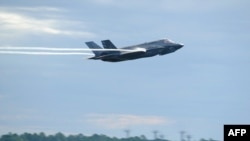China has deployed its premier fighter jets over its nearby seas to counter mounting U.S. military involvement in Asia, analysts say.
Domestically made Chengdu J-20 stealth fighter aircraft are stationed in the country's south for missions in the South China and East China seas, as well as around Taiwan, according to experts and media reports from Asia.
The J-20 has begun "routine training sessions" and combat patrols in the two seas, Beijing's government-regulated Global Times news website said on April 13. The report quoted Ren Yukun, head of the discipline, inspection and supervision team at domestic aircraft maker Aviation Industry Corporation of China, maker of the J-20.
"Presumably, this gives something it can go toe-to-toe with the U.S. over Taiwan or the East China Sea," said Gregory Poling, director of the Asia Maritime Transparency Initiative at the Washington-based Center for Strategic and International Studies.
The U.S. government, which periodically passes warships through the disputed seas in Asia, sent two aircraft carrier groups to the South China Sea in January.
U.S. Asia-Pacific allies Australia, Japan and South Korea have bought F-35s, and Singapore and possibly Thailand will follow, Radio Free Asia reports.
Those developments from the United States prompted China to fly its J-20s, analysts say. Chinese officials regard Washington, a former Cold War foe, as a rival superpower that wants to contain China's expansion into nearby seas.
Disputed waters
Beijing calls about 90% of the 3.5 million-square-kilometer South China Sea its own, clashing with the claims of Brunei, Malaysia, the Philippines, Vietnam and Taiwan. Asian governments value the sea for oil, natural gas, shipping lanes and fisheries.
China and Japan dispute tracts of the East China Sea. Japan, Taiwan and the Philippines align with the United States.
The U.S. government says the South China Sea should remain an international waterway.
"At the least, China says the South China Sea belongs to it, while for the United States, I think the U.S.-side action is to push for internationalizing it," said Huang Kwei-bo, associate professor of diplomacy at National Chengchi University in Taipei. "China doesn't want it that way. I think each side is displaying these [aircraft] for the other to show how powerful they are."
The J-20 could handily interfere with the military flights of other Asian countries, which lack planes of equal caliber, said Jay Batongbacal, associate professor and director of the Institute for Maritime Affairs and Law of the Sea at the University of the Philippines.
"For China, it's important because the capabilities and range of that aircraft will enable it to establish a more consistent and longer-range presence in the air," Batongbacal said.
The J-20, part of a military aircraft program launched in the 1990s, was developed by Chengdu Aerospace Corp. for the Chinese Air Force. It compares in capability to the F-22 and F-35, both U.S.-made stealth fighters.
The United States is getting F-35s into Asia "as fast as it can," Poling said. The U.S. and Chinese militaries are already "near peers" in terms of firepower, he added.
Taiwan, Vietnam on alert
The J-20s may join other Chinese aircraft in routine flyovers of a corner of Taiwan's air defense identification zone, Huang said.
They probably won't dip as far south as the South China Sea's widely disputed Spratly Islands, Batongbacal said, as that could be seen as "overkill" by the militarily weaker Southeast Asian claimant nations.
Vietnam is the country most likely to take notice, Poling said. J-20s will probably help project Beijing's claims to the Paracel Islands in the South China Sea, he said. That island chain is near the Chinese coast and contested vigorously by Vietnam. Vietnam, a historic Russian ally, has grown closer to the United States over the past decade as China expands at sea.
"Hanoi has repeatedly protested against China's deployment of weapons of all types in the South China Sea, but that does not change China's behavior," said Nguyen Thanh Trung, director of the Saigon Center for International Studies at the University of Social Sciences and Humanities in Ho Chi Minh City, Vietnam.
"The deployment of advanced J-20 jets may be interpreted by the Vietnamese government as China's incremental ambition to exert China's claimed sovereignty in the South China Sea airspace," he said.










